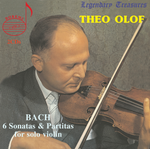|
Back
03/04/2019
“Legendary Treasures: Theo Olof, Volume 1”
Johann Sebastian Bach: Violin Sonata n° 1 in G minor, BWV 1001 – Violin Partita n° 1 in B minor, BWV 1002 – Violin Sonata n° 2 in A minor, BWV 1003 – Violin Partita n° 2 in D minor, BWV 1004 – Violin Sonata n° 3 in C major, BWV 1005 – Violin Partita n° 3 in E major, BWV 1006
Theo Olof (violin)
Recording: Unknown venue (c.1974) – 131’37
Doremi DHR-8065/6 – Booklet in English (Distributed by Naxos of America)

   
Theo Olof recorded Bach’s Sonatas and Partitas for Solo Violin right around the time of his appointment as concertmaster of Amsterdam’s Concertgebouw Orchestra. Not having heard Olof play in a solo or chamber setting before, I was somewhat apprehensive coming to these recordings (reissued by Doremi) for the first time, as not all excellent orchestral musicians possess the personality one generally looks for in chamber music. Yet my worries were wholly put to rest from the beginning of the opening “Adagio” of the Sonata n° 1 in G minor. In high notes especially, Olof can certainly produce the glowing radiance of tone one would expect from a leader of the Concertgebouw, but his approach to Bach is by no means smoothed-over or mechanical. (While multiple-stops are generally quite clean, he does dig into them at times to thrilling effect, as in the first two movements of the G minor Sonata.) Indeed, much of the time he eschews carefully even tone-production in favor of a sense of expressive variety and nuance in which each note “speaks” as it similarly does in each phrase. In this respect Olof reminds me of the great Adolf Busch. I have for some time regretted that Busch died without leaving a complete solo Bach cycle; only a D minor Partita and a C major Sonata survive along with a G minor Sonata drawn from two separate radio broadcasts. Olof’s approach to this music reminds me more of Busch’s than any other I have encountered. What is more, Olof’s technical security is more consistent than that of Busch, and Busch never enjoyed the high-fidelity analogue sound in which Olof’s Bach was captured. An additional trait Olof shares with Busch is a big, rich tone that is certainly penetrating if not always smooth or brilliant. This strikes me as an asset in this repertoire. As accomplished and sensitive as, for instance, Itzhak Perlman and Oscar Shumsky are in the Sei Solo, the overall effect can be just a little too glossy and upholstered for this elegant yet basically austere music. It seems to respond best to either an almost featherweight lightness, such as one hears from Arthur Grumiaux and some of today’s “historically informed” stylists, or (perhaps ideally) just a touch of grit.
In light of all this, what is perhaps especially striking about Olof’s approach to Bach is the quiet intensity with which he so often deploys his ample tone. He is not afraid to remain at piano for long stretches at a time, and in these passages, especially, his unusually detailed and sensitive phrasing makes the listener lean in to hear, as it were. In the B minor Partita, arguably the most introverted and elusive piece in the set, this approach allows Olof to hold one’s attention throughout without trying to inject any superficial drama or excitement.
In a similar vein, I was also particularly struck by the unusually moderate tempo taken in the finales to the G minor Sonata and the C major Sonata. In Olof’s hands, these often dazzling movements, instead, take on a nearly elegaic character. Likewise, the “Preludio” to the E major Sonata is slowed down just enough to emerge as something more than a euphonious showpiece. And the famous “Chaconne” from the D minor Partita brings a kind of plain-spoken emotional strength, and a bit of sinew, in place of brilliance.
In short, I was riveted throughout (in case this point wasn’t already obvious.) I struggle to imagine a more subtly communicative approach to Bach’s solo violin music which, for me, constitutes his most cherished achievement. Olof now joins Adolf Busch and the somewhat more polished Hilary Hahn (especially in her recent Decca recording) at the top of my list of interpreters of these wonderful works. I eagerly await the continuation of Doremi’s Olof edition, of which this set is labeled “Volume 1.”
Samuel Wigutow
|